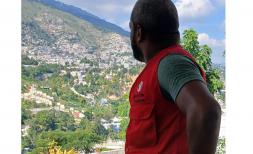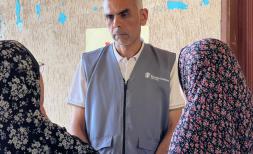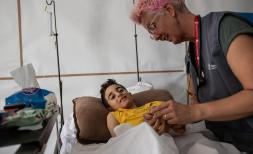Three ways we are making our programmes safe for children with disabilities
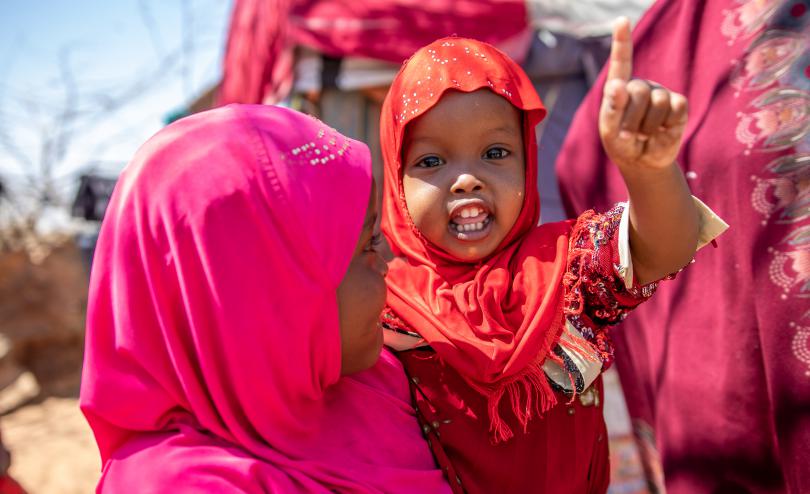
Pictured above: Two-year-old Suhuur lives with her aunty Fosiya and her cousin Amiira in a camp for displaced people in Somalia. Suhuur was born with a disability and has difficulties walking and talking. She receives regular visits from Save the Children’s Family Health Workers.
People with disabilities make up 15% of the world’s population, 150 million of which are children[i]. Save the Children has ambitions that all children have the chance to grow up healthy, be educated and stay safe. Yet, there is much more we need to do to improve how we support children with disabilities through our programmes and advocacy.
Global estimates indicate that children with disabilities are up to four times more likely to experience violence compared to children without disabilities.[ii] There are a number of reasons for this. A child with a disability may be seen as an easy target and assumed to not be able to report the abuse. Negative attitudes in societies towards children with disabilities often allow for abuse of children with disabilities to happen. Furthermore, child safeguarding systems are not tailored to meet the requirements and experiences of children with different impairments.
A significant step in the right direction is the development of the Disability-Inclusive Child Safeguarding guidelines, launched by Save the Children, Able Child Africa and Uwezo Youth Empowerment. The guidelines serve as a practical resource that fills the gap on ‘How’ to effectively make child-safeguarding systems disability-inclusive.
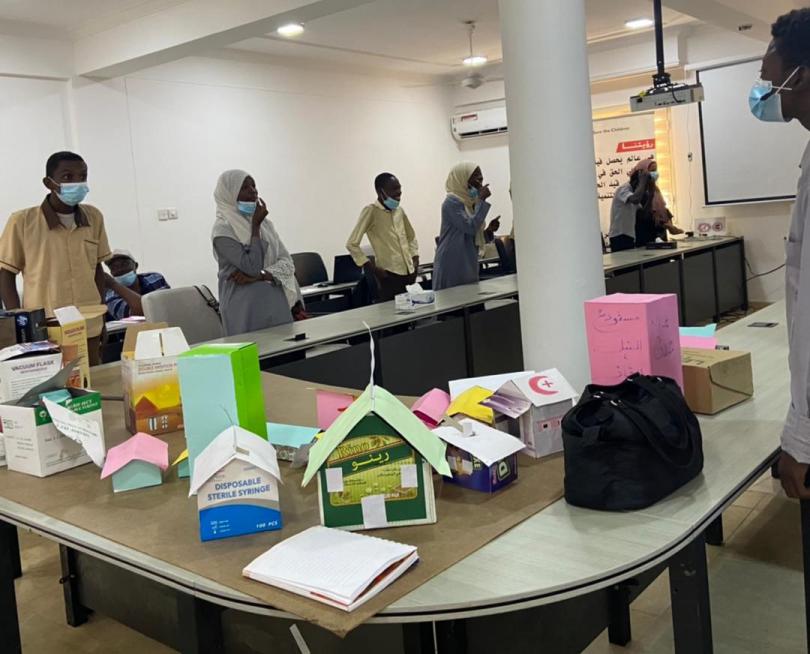
Workshop with children with and without disabilities in Sudan using accessible and diverse materials to guide the conversation
Below are three examples illustrative of what to expect in the guidelines.
1) Make child-safeguarding trainings disability-inclusive and plan for accessible venues, transport and communications.
“The place might be having holes or water channels that a person with vision impairment cannot see and fall into. Or you are in a room that organisers have not oriented you about, then you get difficulties knowing where things you need are, like the toilet. You may also hit yourself on things in the room, or on the wall.” – Gladys
Save the Children in Sudan recently held children’s workshops to support with the development of their strategy planning. In order to ensure the consultations were safe for children with physical and intellectual disabilities and children who are deaf or hard of hearing, the team engaged with Organisations of Persons with Disabilities (OPDs) as they prepared for the event. Adaptations to make the workshop disability-inclusive included selecting an appropriate venue, confirming the suitability of materials, organising accessible transport to bring participants to and from the event, and hiring sign language interpreters.
Disability inclusion was also built into the one-week training on child safeguarding that took place before the consultations. As a result, children with disabilities participated actively and felt safe, while the team learned how small adaptations can allow for more safe and meaningful participation.
2) Adapt key project content to be relevant and sensitive to families with disabilities
“If someone calls me using bad words, you are not considering me as a human being, rather as a thing! Instead of using my proper name, you call me ‘the short one’ or ‘the tall one’, [even though] you know my name!” – Greta
In our Parenting without Violence programming in Somalia, Save the Children Somalia and Finland teamed up with the Finish Abilis foundation to revise project materials to be inclusive of children with disabilities, since parents of children with disabilities often have very different experiences raising their children.
This resulted in a complementary project manual for use by support groups of parents with children with disabilities. The manual aimed to both challenge pre-existing misconceptions about disabilities, but also provide parents with practical adapted advice. With the support of a local OPD, Alla Magan, all relevant project team members were trained on disability rights and disability inclusion in general and the new manual. Save the Children Somalia continues to develop its disability inclusive approach through its newly established Disability Champion’s Network and the recruitment of a disability inclusion expert.
3) Use pre-orientations and reasonable accommodation to engage children with disabilities in policy dialogue
“During meetings, children with disabilities are denied a chance to give their opinions because facilitators don’t value their views due to their disabilities.” – Remy
Save the Children Philippines engaged children with disabilities and their parents in a consultation for the ‘Inclusive Education for Learners with Disabilities Bill’. Save the Children worked with Education Network Philippines and Norfil Foundation to prepare and conduct the consultation. Ahead of the consultation, a pre-orientation on disability was held for all consultation attendees to ensure that the consultation would not reinforce any stereotypes or unintentionally exclude some children with disabilities.
Ahead of the consultation, all children and their parents were asked if they needed some adaptations before, during or right after the consultation (‘reasonable accommodations’)[iii], which were then prepared for. Examples included the availability of sign language interpreters, the opportunity for children to engage in smaller groups that suited their level of understanding, having their parents present in the background, shortened and easy-read texts, and paced presentations. Because of thorough planning, children with disabilities were comfortable with adults present in the consultation and familiar faces helped them feel at ease, comfortable and expressive.
New disability-inclusive child safeguarding guidelines available to all!
The disability-inclusive child safeguarding guidelines were developed over the course of two years with input from over twenty stakeholders operating in the fields of disability rights, development and humanitarian action. They are a complement to existing child safeguarding guidelines and can be integrated into organisations’ existing child safeguarding-systems.
We encourage organisations to refer to the disability-inclusive child safeguarding guidelines and their accompanying summaries, and choose and apply relevant recommendations to improve practice and generate further learning. The full disability-inclusive child safeguarding guidelines can be found in Save the Children’s Resource Center
[i] UNICEF, State of the World’s Children- Children with Disabilities, 2013
[ii] World Health Organization (webpage). Disabilities and Rehabilitation: Violence against
adults and children with disabilities. https://www.who.int/disabilities/violence/en/
[Accessed: 5 March 2021]
[iii] means necessary and appropriate modification and adjustments not imposing a disproportionate or undue burden, where needed in a particular case, to ensure to persons with disabilities the enjoyment or exercise on an equal basis with others of all human rights and fundamental freedoms. UN Convention on the rights of Persons with Disabilities, Article 2
